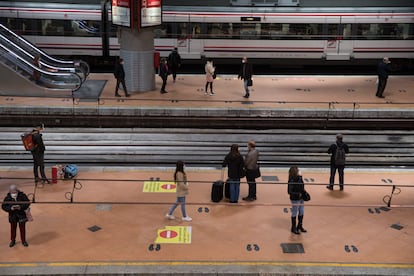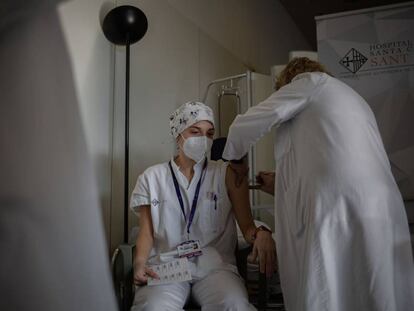Less travel, fear of contagion: Why Spain’s public transportation is facing its biggest crisis ever
The fall in passengers as a result of the coronavirus pandemic has led to unprecedented financial losses that could affect the sector for years to come
The coronavirus crisis has changed urban mobility habits in Spain. People are now traveling less for various reasons: the pandemic has promoted remote working, led to a rise in distance education, caused job losses and also prompted the closure of social hubs like bars and restaurants. Last year, urban travel increased once restrictions were eased, albeit not to pre-pandemic levels. But what did not bounce back was the use of public transportation.
The number of passengers on public transportation has fallen by half in six large Spanish cities, compared to figures from 2019, according to data analyzed by EL PAÍS. While overall traffic in cities – most of which is made up of cars – has fallen between 15% and 25%, depending on the source, public transportation use has dropped between 45% and 50%. Experts attribute this drop to fear of contagion and warn that it poses the biggest crisis to Spain’s public transportation system in history.
Transportation businesses are bankrupt. We have enormous lossesÁlvero Fernández Heredia, manager of city buses in Valladolid
“When the coronavirus arrived, public transportation was demonized and people continue thinking that it is a high-risk scenario, although science has shown that it isn’t: there is the perception that the risk [of contagion] on the Metro is greater than in a family gathering, and there is no reason why this should be the case,” explains David Lois, who teaches social psychology at the National Distance Education University (UNED) and is a public transportation researcher at the Polytechnic University of Madrid.
A recent survey by the consumer group OCU found that 67% of Spaniards feel unsafe on public transportation, with fewer respondents feeling less secure in bars (50%), shopping centers (47%) and supermarkets (29%). This negative perception has not changed since last summer.
It is true that at the beginning of the pandemic, the risk of infection was greater as no coronavirus safety measures had been introduced, unlike in other places where crowds were known to gather. But since then, numerous scientific studies have shown that with the current measures in place – mandatory use of face masks, disinfection, air filtering – public transportation does not necessarily represent a risk. In Japan, which has a very thorough contact tracking system, no coronavirus outbreak has been linked to public transportation. In Spain, a team from the national research institute CSIC analyzed June samples from the Valencia Metro system – taken from railings, vending machines, turnstiles, stairs and air conditioning filters – and concluded that the virus was not present in the underground rail network.

“There are people who used to take the Metro or the Cercanías commuter train, who now travel by car,” says Samir Awad, a professor of transportation planning at the European University.
José Carpio-Pinedo, a consultant on urban mobility, says the unequal use of cars is partly due to the coronavirus lockdowns, which shut down some industries but not others, like the logistics sector. “If the logistics centers that have not shut down are located on the outskirts of cities and are additionally not well connected to public transportation, their workers are going to go by car, and this is still happening,” he explains. “Meanwhile, leisure activities in the city centers, which are generally reached by public transportation, have fallen. This unevenly affects the use of cars.”
The fall in passengers is most evident in intercity bus and train networks, which are most often used by commuters who travel into the city center from other municipalities or to large industrial centers on the city outskirts. In June and July, when most travel restrictions were lifted, cities like Madrid, Seville and Málaga recorded half the number of passengers than in the same months in 2019. This number fell even more in September and October.
“The fall is similar in all of Europe, while in Latin America it is falling even more,” says Dionisio González, from the International Association of Public Transport (UTIP), a platform for 1,800 businesses from around 100 countries to share knowledge. According to Germany’s federal statistics office Destatis, the number of public transportation users fell 41% in 2020 with respect to the previous year.
The drop is taking a heavy financial toll on transportation companies in Spain. “Transportation businesses are bankrupt. We have enormous losses,” says Álvaro Fernández Heredia, the manager of city buses in Valladolid, who estimates the loss at €4.8 million, “more than in the previous 15 years.” Other municipal bus services are also expecting multi-million-euro losses: €14 million in Valencia and Málaga, €22 million in Zaragoza, €24.5 million in Seville. And this does not take into account the additional costs of coronavirus safety measures: daily disinfections, protective screens, personal protective equipment for workers, better ventilation systems.
We have to explain very clearly that public transportation is safeMarta Serrano, manager of city buses in Valencia
“We are making an effort, but it is not infinite. We need the government to finance part of the cost,” says Natalia Chueca, Zaragoza’s city councilor for mobility.
Industry experts are not optimistic about the sector’s prospects for recovery. “While the pandemic goes on, the sector will continue to be affected,” says Antonio García Pastor from Avanzabus, which manages buses in 40 Spanish cities.
“I have not known another crisis like it, because it brings together the effects of the lockdown, the recommendation not to travel, remote working, and unemployment. It is an explosive mix for public transportation, a sector that employs 37,000 people in Spain,” says Jesús Herrero, the secretary-general of the Urban and Metropolitan Transportation Association (ATUC), who says that 2020 ended with 55% of the passengers that used the services the previous year. “It has led to a €1.2 billion fall in income from ticket sales, not including those from Cercanías.”
The public transportation consortium in Madrid, which includes buses, the Metro line and Cercanías trains, recorded 1.6 billion passengers in 2019. In 2020, that number fell to 900 million. “People are taking fewer trips and, if they can, they prefer to stay close to their neighborhoods and towns; foot traffic is at levels similar to previous years,” says Luis Miguel Martínez, the manager of the consortium, who warns the crisis could last for years: “2021 will be a year of transition. We believe we won’t recover the figures from 2019 until 2023.”
The other pandemic: pollution
“The private vehicle is absorbing the demand that used to be serviced by public transportation. Now we are scared of this pandemic, but there is another one involving air quality that also causes deaths, although they are not as visible,” says Carpio-Pinedo. Low air quality can also impact the spread of the current coronavirus pandemic. A recent study from Harvard University found that living in an area with high air pollution (specifically with high concentrations of particulate matter that is 2.5 micrometers in diameter or less) has a direct relation with higher death rates from Covid-19. “For the coronavirus, vaccination is arriving now, but for pollution, the vaccine is public transportation, yet we are letting it fall apart and no one cares,” says Fernández Heredia.

“Allowing collective transportation to deteriorate will push cities to the breaking point. There is explicit support for the auto industry, in which more than €10 billion will be invested in three years, but not in public transportation, which is more important on a social level,” says professor David Lois. The Transportation Ministry says that €4.1 billion will be invested in urban mobility over the same time period, but not all of this funding will go towards public transportation.
How can the crisis be solved?
Given the precarious state of Spain’s public transportation network, what then is needed to save it? Experts and industry leaders all agree that a strong official campaign is required to show the public that public transportation is safe. “The messages from authorities so far have been confusing,” says Dionisio González, from the UITP. The Transportation Ministry says it is working on a campaign, but that it won’t be launched until the pandemic is over because there continue to be restrictions on travel. “We have to explain very clearly that public transportation is safe and what’s more, that is the only one that guarantees universal urban mobility,” says Marta Serrano, a manager of city buses in Valencia.
Experts also agree that the system should be strengthened even if it is in crisis. In other words, more bus lanes, greater frequency of Metro and Cercanías trains to avoid crowding, investment in new vehicles and establishing new bus lines to less connected areas.
Municipal authorities are also requesting up to €400 million in emergency investment, and a public transportation law in the long term that will create better funding for the sector. “We are one of the few countries in Europe without one,” notes Dionisio González. Without such legislation, there is a risk that service will decline or that frequencies will be reduced. While no operator is contemplating such measures yet, Míriam Manrique, financing director for the Barcelona Metropolitan Area, issues a warning: “Modifying people’s mobility habits takes decades, yet it can be lost in a year. If people switch to cars, we will end up with a significant air quality problem.”
With reporting by Enrique Müller.
English version by Melissa Kitson.
